If you see the error message Windows Sandbox failed to initialize, Error 0x800736b3, 0x80070490, etc. on your Windows 11/10 PC, read this post to learn how to fix the issue. Windows Sandbox provides a temporary desktop environment to run untrusted or questionable applications in isolation. It allows users to try out new software or browse potentially unsafe websites without risking the main operating system.
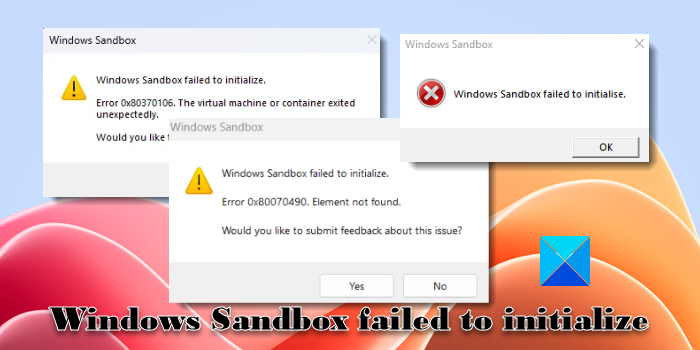
A few users have reported that when they try to launch Windows Sandbox, a message appears on their screen and it fails to start. The complete message reads:
Windows Sandbox failed to initialize.
The above message is sometimes accompanied by different error codes, such as:
Windows Sandbox failed to initialize.
Error 0x80370106. The virtual machine or container exited unexpectedly.
Would you like to submit feedback about this issue?
or,
Windows Sandbox failed to initialize.
Error 0x800736b3. The referenced assembly is not installed on your system
Would you like to submit feedback about this issue?
or,
Windows Sandbox failed to initialize.
Error 0x80070490. Element not found
Would you like to submit feedback about this issue?
There’s another variation of the same message that you may encounter on your system. The message reads Windows Sandbox failed to start and is linked to error codes 0x80070002, 0x80070569, 0x800706d9, 0xc0370106, 0x80070057, etc.
Why is my Windows Sandbox not working?
There could be many reasons behind the issue when Windows Sandbox fails to initialize. This may happen when virtualization is not enabled or the Windows Sandbox feature is not enabled on your system. This could also happen due to Hyper-V conflicts, third-party software conflicts, and outdated or incompatible drivers.
If you’re experiencing issues with loading Windows Sandbox on your Windows 11/10 PC, read this post to learn how to fix the issue.
Fix Windows Sandbox failed to initialize error
TheWindowsClub has over 15K posts that can help you troubleshoot Windows, and based on our experience, we suggest the following solutions to fix the error message Windows Sandbox failed to initialize, Error 0x800736b3, 0x80070490, etc:
- Check system requirements
- Enable supported components
- Enable relevant services
- Install missing Visual C++ Redistributables
- Reset Windows Sandbox
Let us see this in detail.
1] Check system requirements
First and foremost, make sure your system meets the minimum requirements for Windows Sandbox. It is currently not supported on Windows Home, so make sure you’re running it on Windows 10 Pro or Enterprise, build 18305, or Windows 11 (64-bit version). The rest of the hardware requirements are as follows:
- ARM64 (for Windows 11, version 22H2 and later) or AMD64 architecture
- At least 4 GB of RAM (8 GB recommended)
- At least 1 GB of free disk space (SSD recommended)
- At least two CPU cores (four cores with hyper-threading recommended)
2] Enable supported components
Windows Sandbox relies on virtualization technology to create an isolated environment for installing and running applications, and it requires specific components and processes to function properly. Following are some key components required for running Windows Sandbox:
A] Virtualization Technology: Make sure virtualization is enabled in your computer’s BIOS or UEFI settings. The virtualization technology is usually referred to as Intel Virtualization Technology (VT-x) for Intel processors or AMD Virtualization (AMD-V) for AMD processors. Refer to your system’s documentation for detailed instructions on how to enable virtualization on Windows 11/10.
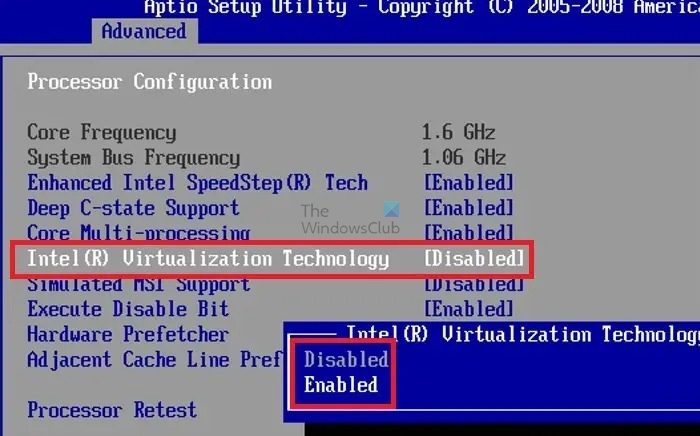
B] Hyper-V: Hyper-V is a hypervisor-based virtualization software that comes bundled with Windows 10 Pro and Enterprise editions. You need to install and enable Hyper-V on your system for Windows Sandbox to work.
Press Win+R and type ‘optionalfeatures’ in the Run dialogue box. Press the Enter key. In the Windows Features popup, make sure the option for Hyper-V is checked.
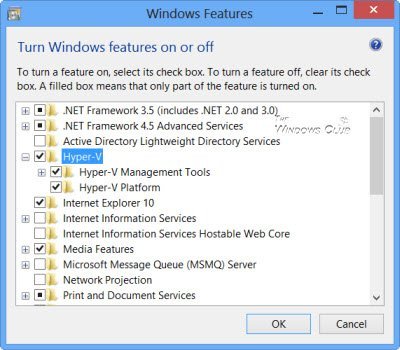
C] Windows Sandbox: Certain advanced features, including Windows Sandbox, are disabled by default in Windows. You need to enable Windows Sandbox on your PC before trying to launch the app.
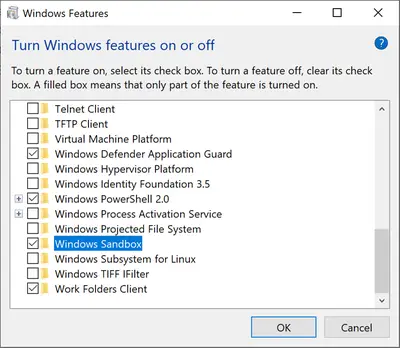
Navigate to Windows Sandbox in the Windows Features popup, and make sure the option is checked. Alternatively, open PowerShell and execute the following command
Enable-WindowsOptionalFeature -FeatureName "Containers-DisposableClientVM" -All -Online
Note: You need administrative privileges to enable and configure Windows Sandbox and Hyper-V. Make sure you have the necessary permissions or log in as an administrator to enable these features.
3] Enable relevant services
A few services (background processes in Windows) are specific to Windows Sandbox and are required for it to function properly. If these services are stopped, you need to start them manually to run the Sandbox environment.
Type ‘services’ in the Windows Search bar and click on the Services app on top of the search results. In the Services window, navigate to Hyper-V Remote Desktop Virtualization Service and double-click on it. Select Automatic under Startup type and click on the Start button. Click Apply and then OK.
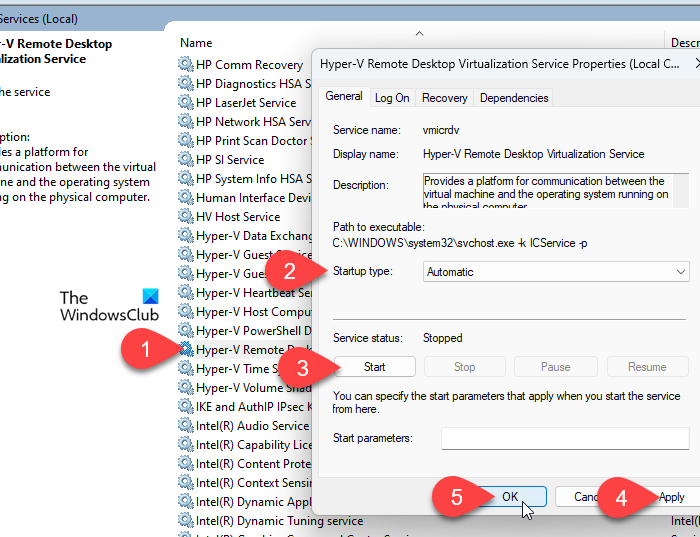
Apply the same setting to all Hyper-V services, including:
- Hyper-V Host Service
- Hyper-V Time Synchronization Service, and
- Virtual Disk
4] Install missing Visual C++ Redistributables
Visual C++ Redistributables are necessary code libraries that can prevent Windows Sandbox from initializing if they are missing or improperly installed. You may reinstall them on your PC to ensure the proper working of Windows Sandbox.
Navigate to the official Microsoft Visual C++ download page and download the required version of Visual C++ Redistributables. Double-click on the downloaded files to install them on your PC. Reboot if prompted.
5] Reset Windows Sandbox
Next, try resetting Windows Sandbox to its default state.
Press Win+R, type ‘optionalfeatures’ in the Run dialogue, and click OK. In the Windows Features dialog, scroll down and uncheck the Windows Sandbox option. Click OK and wait for Windows to uninstall and disable the feature. Restart your PC to apply the changes.
Again, open the Windows Features dialogue and check the Windows Sandbox option. Click OK and wait for Windows to install and enable a clean version of Sandbox on your system. Reboot the PC and check if Windows Sandbox is now able to initialize.
If the issue persists, run the SFC and DISM tools to fix corrupt or missing system files. Also, install pending Windows updates if any, and check for software conflicts by running Windows in a clean boot state.
I hope this helps.
Read: How to transfer Files to Windows Sandbox.
Is Windows Sandbox available for Windows 11 Home?
Windows Sandbox is currently supported only on Pro/Enterprise/Education editions. Though it is officially not available for Windows Home, you may install and enable Windows Sandbox in the Home edition using workarounds, provided your system meets the minimum hardware requirements for running Sandbox.
Read Next: Windows Sandbox item is greyed out.
Leave a Reply